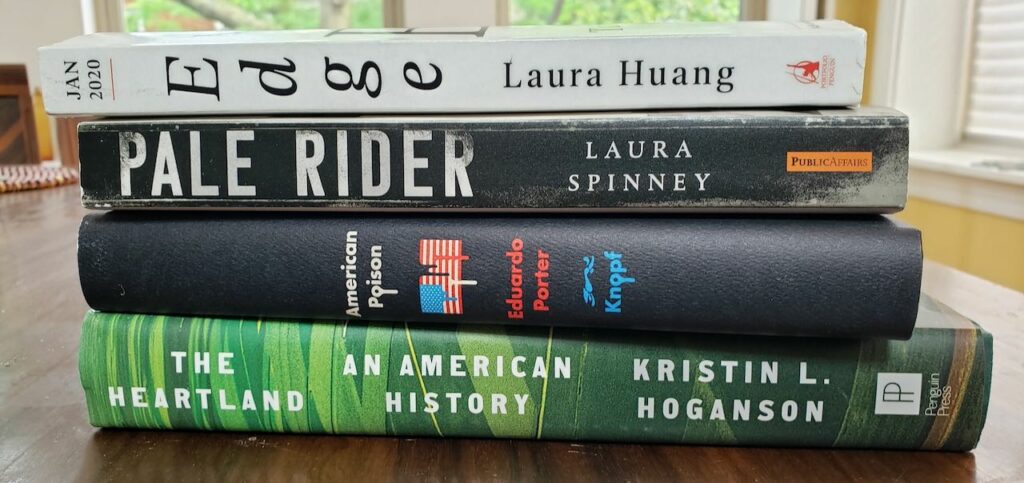Spoiler alert: My summer book list is not exactly beach reading. After all, Chicago beaches are closed because of the COVID-19 pandemic. Plus, I confess to taking a bit of poetic license with the description of this list since I read some of these before summer started. But who’s counting?
The important thing is that these four books hold key insights into what’s going on today with political and economic tensions, what got us here, how the pandemic and our reactions to it might shape the future, and how to face with alacrity the challenges the world throws at us.
PALE RIDER: The Spanish Flu of 1918 and How It Changed the World. By Laura Spinney. This book is a fantastic global, historical overview of the 1918 Great Flu pandemic –which killed my great-grandfather– and its aftermath and impact on population and health trends, public policy, attitudes toward science, living habits, religion, literature, art, diplomacy, and even on historical memory itself. Spinney’s global perspective is welcome, not least in her description of how people talked about the pandemic, which though it is now called the “Spanish” flu was circulating in the United States for at least two months before it showed up in Spain. “In Senegal it was the Brazilian flu and in Brazil the German flu, while the Danes thought it ‘came from the south’,” Spinney writes. “The Poles called it the Bolshevik disease, the Persians blamed the British, and the Japanese blamed their wrestlers: after it first broke out at a tournament, they dubbed it ‘sumo flu’.” This kind of thing should feel familiar amid the politicization of what to call COVID-19. Pale Rider is so rich in detail and insight that no summary can begin to do it justice.
EDGE: Turning Adversity into Advantage. By Laura Huang. EDGE is an acronym for Enrich, Delight, Guide, and Effort: four principles for succeeding where hard work is necessary but not sufficient. Written by a Harvard Business School professor who opens with a story of how she and a colleague almost got kicked out of Elon Musk’s office but turned things around, this book is full of thought-provoking and useful mindset shifts that will get you past frustration and help you to achieve your goals in business and life. EDGE is a fantastic set of ideas for learning to manage the curve balls life throws at you, flipping biases and stereotypes to your favor, and turning constraints into tools of liberation.
AMERICAN POISON: How Racial Hostility Destroyed Our Promise. By Eduardo Porter. You may have caught the recent statement by the rating agency, Moody’s Investors Service, that racial inequality could hurt the United States’ credit rating. “Even if the immediate credit implications of the protests were limited, rising social risk, if left unaddressed by policymakers, can carry negative longer-term implications,” William Foster, a senior credit officer at Moody’s, told investors in the wake of the protests over the police killing of George Floyd. Moody’s cited a report from McKinsey estimating that closing the racial wealth gap could add 6 percent to GDP. Eduardo Porter’s thoughtful, deeply researched, and eminently timely book is a sobering analysis of the origins and current dynamics of the racial divisions that have stunted economic and social institutions. Though his prognosis is pessimistic, he still sees a glimmer of hope: “As the ethnic identity of the American population continues to meld, barriers designed in a time of more clear-cut racial definitions seem unlikely to hold. Maybe the United States even has a shot at forging a melting pot for real.”
THE HEARTLAND: An American History. By Kristin L. Hoganson. It’s hard to believe that this September it will be six years since I moved back to the Midwest, a region that is so important to America’s economy and politics. Since 2014, as I have come to realize just how deeply my roots here have influenced me, I’ve been reading as much as I can both about Chicago’s history and present and about the wider region. Kristin Hoganson’s detailed research and original analysis make this book well worth a read not just for Midwesterners but for anyone who wants to understand the United States’ history and future. She deftly debunks the idea of the heartland as an insulated core and depicts a more accurate version of the region as a crossroads. “The heartland myth reveals that the struggle to define the nation has been conceived as a contest between insiders and people on the margins,” Hoganson writes. “The mythical heartland, in other words, emerged as a political tool, its capacity to bind balanced by its ability to divide. And here’s the irony. No matter which competing purpose it has served, it has achieved the same result: exacerbating the fundamental challenge of comprehending the world by insisting on fixity instead of flux, insularity instead of interdependence.”
What have you read lately that’s worth sharing? I would love to hear your recommendations.
This article is part of my LinkedIn newsletter series, “Around My Mind” – a regular walk through the ideas, events, people, and places that kick my synapses into action, sparking sometimes surprising or counter-intuitive connections.
To subscribe to “Around My Mind” and get notifications of new posts, click the blue button on this page. Please don’t be shy about sharing, leaving comments or dropping me a private note with your own reactions.
For more content, including guest posts and ways to engage me for keynotes or workshops, please visit www.thegrayrhino.com.
- The Gray Rhino Wrangler on Substack - January 1, 2025
- Gray Rhino Risks and Responses to Watch in 2024 - January 10, 2024
- In the Media 2023 - December 31, 2023


